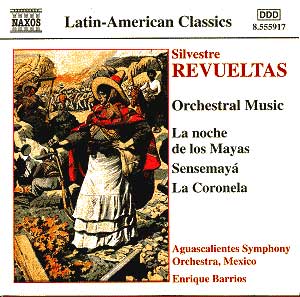Sensemayá undoubtedly is Revueltas’ most
popular and best-known orchestral work. The present orchestral version
was made in 1938 whereas the original 1937 version is a setting for chorus
and small orchestra of a poem by Nicolás Guillén. There
also is a version for chamber orchestra. The poem deals with the ritual
chant performed while killing a snake and tells the story of a princess
transformed by a magician into a snake, in revenge of her rejection of
him. A snake hunt is set up and the snake is eventually killed by the
magician. The spell is broken and the princess has her soul back. The
villagers rejoice. This primitive, ritualistic tale inspired a powerfully
evocative, colourfully scored work which, to a certain extent, might be
regarded as some sort of Mexican Rite of Spring. The elemental
forces are suggested by the hypnotic repetition of the main rhythmic gesture
underlining the whole work and which is in fact the musical translation,
as it were, of the purely phonetic refrain in Guillén’s poem. Stravinsky
may not be very far, but the music is pure Revueltas and has a quintessential
Mexican character. No wonder it became widely popular and championed by
celebrated conductors such as Stokowski, Bernstein, Batiz, Mata and Salonen,
to name but a few. I would now like to hear the original version for voices
and small orchestra.
Revueltas composed several film scores and made some
concert suites of them, such as the comparatively well known Redes.
The orchestral suite of La noche de los Mayas was made
by José Yves de Limantour. Both the film and the score were ambitious
projects, though I must confess that I never saw the film (I wonder
who has?) and thus cannot comment about the real part played by the
music. In any case, Limantour did a wonderful job with what must have
been a rather fragmentary score, and the result is a substantial symphonic
fresco which has often been compared to the impressive Mexican mural
frescos (old and new). Revueltas conjures up a fantastic sound world
in accordance to his own all-embracing vision of the Maya world. Colourful
scoring and powerful rhythms drive the music along, in turn menacing,
violent, dreamily mysterious, at times tender, ecstatic and exalted.
The rarity here is the ballet score La Coronela,
Revueltas’ last major work which he did not live long enough to complete.
It was completed from the short score by Blas Galindo and orchestrated
by Huizar. Some twenty years later, Limantour made a new arrangement
for a new orchestration by Moncada. For the last episode, he included
some music from scores written by Revueltas for two films about the
Mexican Revolution. The notes do not say much about the dramatic content
of the libretto by Falkenstein, except that it deals with Mexican life
at the beginning of the 20th Century and is inspired by,
or at least based on, paintings by José Guadalupe Posada. The
music is again very fine, vintage Revueltas and deeply Mexican in feeling,
with nevertheless more than one touch of sarcastic humour and irony
such as the allusion to The Last Post in the fourth section The
Last Judgement. This is a worthwhile addition to Revueltas’ discography
though it has already been recorded at least once before (KOCH 3-7421-2
which I have not heard).
There are many fine versions of Sensemayá
and of La noche de los Mayas, but the present readings
are, to my mind, excellent, though I found that of Sensemayá
a bit cautious, but remarkably well recorded (some details of orchestration
are particularly clearly heard here). However, Barrios has a real feeling
for the music and conducts committed readings of these superb scores
by Mexico’s greatest composer. I now sincerely hope that this release
will be the first of a complete recording of Revueltas’ orchestral music,
for there are still several half-forgotten scores that definitely deserve
to be re-appraised. Recommended, particularly so for the inclusion of
the rarely heard ballet La Coronela.
Hubert Culot


